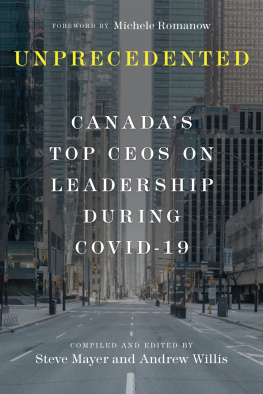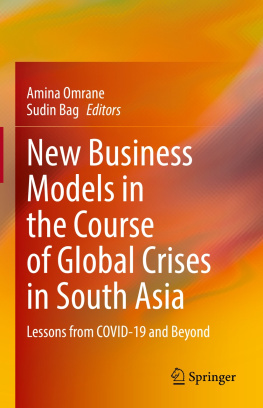No part of this book may be reproduced in any form or by any electronic or mechanical means including information storage and retrieval systems, without permission in writing from the author. The only exception is by a reviewer, who may quote short excerpts in a published review.
The information presented herein represents the views of the author as of the date of publication. This book is presented for informational purposes only. Due to the rate at which conditions change, the author reserves the right to alter and update his opinions at any time. While every attempt has been made to verify the information in this book, the author does not assume any responsibility for errors, inaccuracies, or omissions.
Introduction
T his book was born out of the tremendous challenges faced by the hospitality industry during the Covid-19 pandemic. Its for all of the restaurant owners and brewers who stood together to come back from the unthinkable. Its your fight that inspires all of us entrepreneurs, and shows us that bouncing back from any setback is possible.
This is the story of your journey during the COVID-19 pandemic. Looking back now, it is hard to believe, but in the span of seven days in March, the countrys hospitality industry shut down. Completely. As a CPA who specializes in restaurants, I had a unique vantage point to what was really happening. On March 8, I was scheduled to speak at the annual International Restaurant Show in New York City. On March 13, I had an in-person visit with a client located two hours east of Seattle. And by the early morning hours of March 14, as I boarded my red-eye from the Seattle airport, I watched as the international terminal was closed. The airport became vacant. The other passengers and I were fully aware that when we landed on March 14 on the East Coast, shutdown orders were going into effect. City after city announced stay at home orders. Roads were deserted. Families locked themselves inside their houses. And overnight, the nations largest employer, the hospitality industry, was on life support.
Not all Americans were personally impacted by the early days of COVID-19 and the related shutdowns. While these governmental actions, necessary to control the spread of the disease, were particularly devastating to business owners, the hospitality industry was front and center. While other businesses could operate remotely, there was no remote option for a bartender who relied on tips, or a business owner who on the best month earned a 2 percent profit margin.
Suddenly, every one of my clients had a business at risk of failing. In the wildest scenarios of risk, who would have ever imagined sales suddenly going to zero for the foreseeable future? And because payroll is always paid after the busy weekends, many of our restaurant clients had another full payroll to survive if they were going to make it.
One of my restaurant clients in Philadelphia had been open less than six months after investing over $200,000 in renovations. Their vision was to create a beautiful space and a new brand, with the goal of this being the first of many in the region.
The owner, with over 50 years of experience and known globally for his holdings in New York City, suddenly found himself fully exposed to something he could have never imagined. These werent just his businesses, they were his legacy, and he was staring failure square in the eye.
On the morning of March 15, his manager called me with the news that their entire staff was being laid off the next day. The doors were closing, with no knowledge of when or if they would reopen. We needed to get on the phone with every vendor to let them know the restaurant was not going to be paying its bills until the crisis had passed.
With little else that could be done, the owner and his managers spent the rest of the week driving around suburban New York City, delivering their inventory of the highest quality steaks to people who had been their loyal customers for decades. The city was shut down, and the owner couldnt stomach letting such good product go to waste while his entire customer base was stranded at home.
I knew this was more than a passing story for the 24-hour news cycle. These were big moves. Cities closed. States on lockdown. This was definitely going to last longer than weeks, and possibly longer than months.
As a company, we immediately made the decision to be a beacon of hope to our clients. Regardless of time of day, if they called us we were going to answer. And as many of our clients pivoted to doing take-out orders and shifts on the grill to stay afloat, we did the research on any and every government program available.
It wasnt pretty, and there werent answers for everything. But we tried to be always honest, and encouraging when we could. After all, we had to believe things would get better. This couldnt be the end of the largest industry in the US economy. These owners were fighters. There had to be a way out. We just didnt know when.
We quickly realized that the accounting world too had changed overnight. This was a new game. The tools we had pre-COVID just werent good enough. Our clients were frazzled. Fearful. Lost. And they needed answers. Fast.
Everything we had done prior to March 13, 2020 was now irrelevant. After all, the usual year-over-year reports showing March 2020 against March 2019 had no relation to what these clients were facing each day they walked through their doors and looked at their deserted dining rooms.
Ironically, for many of our clients, January and February of 2020 had been some of their best months on record. Just like the sailors enjoying a Sunday morning on December 7, 1941 in Pearl Harbor, the pandemic struck our clients when they were completely unprepared for bad news.
I remember vividly talking to one of my clients who was paralyzed by the realization of what was in front of him. After leveraging everything he had to open two restaurants over a three-year period, he had cashed his first paycheck to himself on February 18, 2020. One month later, his restaurants had to close indefinitely, with only the one paycheck in his personal account.
These were dark times. But as easy as it was to think about how horrible the situation was, the last thing our clients needed to do was look backwards. If they were going to survive, they needed to start preparing for the biggest bounce back of their careers.
Of course, that would be easier said than done. Business would not be the same as it was. We knew there had to be an openness to change. To adapt to this new reality, everyone needed to be open to different ideas, new processes, and innovative tools.
In those early days I found myself trying to harness every great comeback story I could think of. Growing up as a competitive golfer, I knew all too well what a bad round felt like. And just like sports, to come back after a bad shot or game, a bounce back was going to require a complete shift from the past and intense focus on the future.
Cash Is King
Theres an old saying in business: cash is king. As the lockdown took hold, this was never more true. The one thing every business owner knew as they woke up on March 14 to a country on lockdown, the comeback needed to start with cash flow .
To help our clients adjust, we quickly shifted our reporting to a cash flow budget. We offered any business leader who was interested a budget template, only this one was weekly, with cash flow at the bottom.















